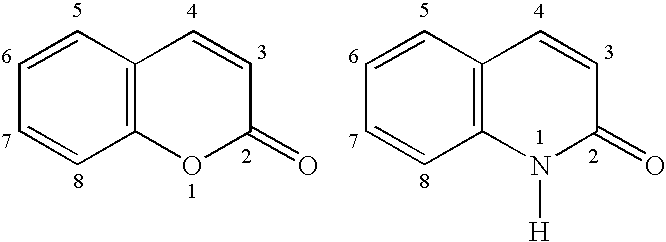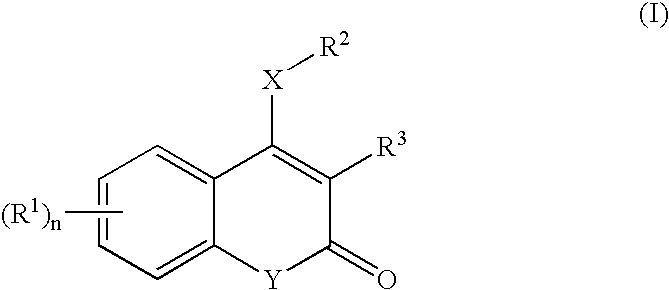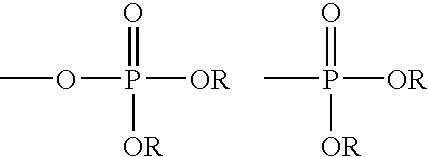3,4-Disubstituted coumarin and quinolone compounds
a technology of quinolones and coumarins, which is applied in the field of 3, 4disubstituted coumarin and quinolone derivatives, can solve the problems of patients treated with this therapy not showing a sufficient antiviral response, the availability of organic compounds derived from natural sources, and serious world-wide health problems, and achieves high substituent tolerance
- Summary
- Abstract
- Description
- Claims
- Application Information
AI Technical Summary
Benefits of technology
Problems solved by technology
Method used
Image
Examples
example 1
[0479]
[0480] To the mixture of 1 (60 mg, 0.37 mmol) and K2CO3 (100 mg, 0.73 mmol) in acetone (3 mL), 2 (103 mg, 0.56 mmol) was added slowly. Then the reaction was stirred at 65° C. overnight. After cooled down, and filtered, the solvent was removed, the given residue was purified using PTLC (eluent: EtOAc / Petroleum ether=1:3) to give 3 (13.9 mg, 10%) as solid.
[0481] LC-MS (6.77 min, ES+): calcd: 478.10; Found: 479.48. 1H NMR (CDCl3): 7.72˜7.63 (m, 2H), 7.62˜7.52 (m, 3H), 7.52˜7.43 (m, 2H), 7.43˜7.34 (m, 3H), 7.314 (t, J=7.5 Hz, 1H), 5.13 (s, 2H), 3.977 (s, 2H).
[0482] LC-MS (6.81 min, ES+): calcd: 478.10; Found: 479.41. 1H NMR (CDCl3): 7.656 (d, J=8 Hz, 1H), 7.627 (AABB, J=80.5, 8.5 Hz, 4H), 7.57 (t, J=7.5 Hz, 1H), 7.455 (AABB, J=52, 8 Hz, 4H), 7.403 (d, J=8 Hz, 1H), 7.309 (t, J=7.5 Hz, 1H), 5.138 (s, 2H), 3.978 (s, 2H).
[0483] LC-MS (6.65 min, ES+): calcd: 370.16; Found: 371.45. 1H NMR (CDCl3): 7.72 (d, J=8.5 Hz, 1H), 7.523 (t, J=8.5 Hz, 1H), 7.376 (d, J=8 Hz, 1H), 7.297 (t, J=...
example 2
[0493]
[0494] POCl3 was added slowly to the solution of 1 in DMF at −5˜−10° C. (ice bath). Then the mixture stirred for 1 hr at r.t. and for another 2 hrs at 60° C. After cooling down, the mixture was poured to the crushed ice in the flask and stored at 0° C. overnight. Then filtered, and washed down with 5% Na2CO3 solution and water followed by drying in vacuum to give 2.
[0495] 4-Methyl aniline was dissolved in MeOH and added slowly to the mixture of 2 and Et3N in MeOH and in a couple minutes the precipitation of 3 formed. After filtration, washing down with MeOH, and drying in vacuum amine was added to the solution 3 in THF and the mixture stirred overnight followed adding NaBH4 to acquired 4. And VQ36344 is the result of the direct reduction of 3.
[0496]1H NMR (CDCl3): 7.581 (br, 1H), 7.44 (t, J=7.5 Hz, 1H), 7.351 (d, J=7.5 Hz, 1), 7.301 (d, J=7.5 Hz, 1H), 7.023 (t, J=7.5 Hz, 1H), 7.017 (AABB, J=93, 7.5 Hz, 4H), 4.733 (s, 2H), 4.2 (br, 1H), 3.818 (s, 3H), 3.614 (d, J=7.5 Hz, 1H)...
example 3
[0499]
[0500] To the mixture of 1 (50 mg, 0.285 mmol) and K2CO3 (197 mg, 1.43 mmol) in acetone (3 mL), 2 (158 mg, 0.854 mmol) was added slowly. Then the reaction was stirred at 65° C. overnight. After cooled down, and filtered, the solvent was removed, the given residue was purified using PTLC (eluent: EtOAc / Petroleum ether=1:3) to give 3 (81.3 mg, 74.3%) and 4 (23.2 mg, 21.2%) as solids.
[0501] LC-MS (6.42 min, ES+): calcd: 383.48; Found: 384.39. 1H NMR (CDCl3): 7.85 (dd, J=8.0, 2.0 Hz, 1H), 7.326 (dt, J=9.0, 2.0 Hz, 1H), 6.961 (t, J=7.5 Hz, 1H), 6.88 (AABB, J=46, 8.5 Hz, 8H), 6.66 (d, J=8.5 Hz, 1H), 3.42 (s, 2H), 3.188 (s, 2H), 2.146 (s, 6H).
PUM
| Property | Measurement | Unit |
|---|---|---|
| Molar density | aaaaa | aaaaa |
| Molar density | aaaaa | aaaaa |
| Molar density | aaaaa | aaaaa |
Abstract
Description
Claims
Application Information
 Login to View More
Login to View More - R&D
- Intellectual Property
- Life Sciences
- Materials
- Tech Scout
- Unparalleled Data Quality
- Higher Quality Content
- 60% Fewer Hallucinations
Browse by: Latest US Patents, China's latest patents, Technical Efficacy Thesaurus, Application Domain, Technology Topic, Popular Technical Reports.
© 2025 PatSnap. All rights reserved.Legal|Privacy policy|Modern Slavery Act Transparency Statement|Sitemap|About US| Contact US: help@patsnap.com



